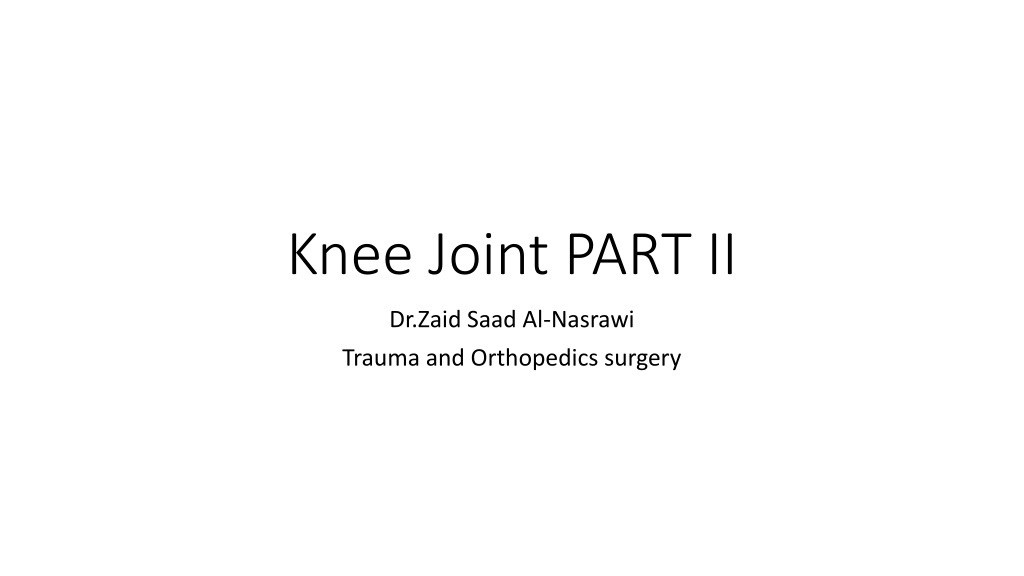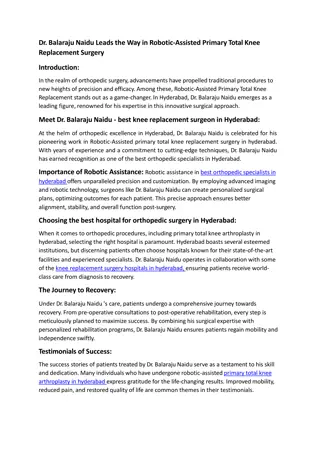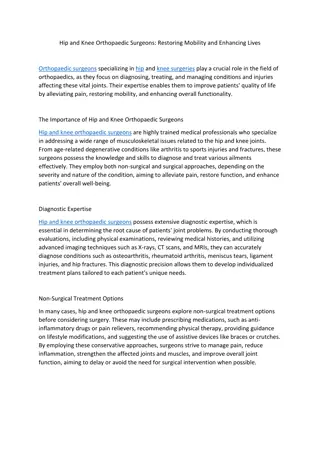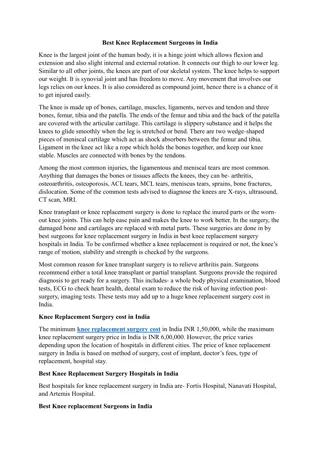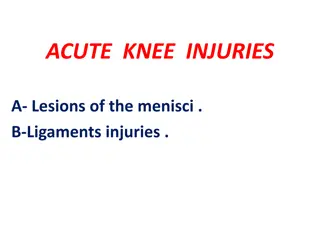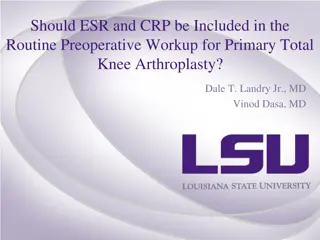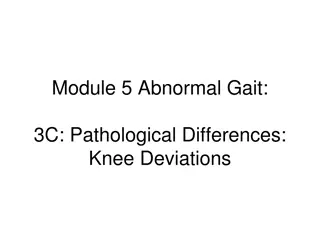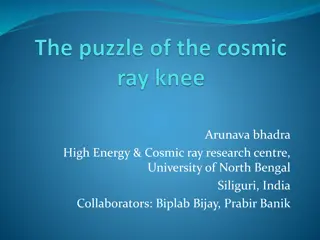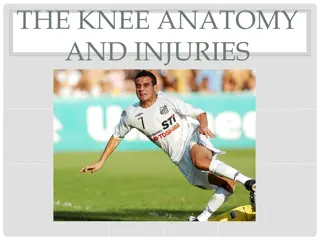Understanding the Menisci of the Knee Joint
Magnetic Resonance Imaging (MRI) is crucial in assessing knee joint internal derangements, including the menisci. These C-shaped structures play a vital role in providing stability, distributing weight-bearing strain, and facilitating joint movement. The medial and lateral menisci have distinct attachments and functions, with the medial meniscus being more prone to injury. MRI reveals the hypointense nature of the menisci and aids in evaluating their integrity for proper diagnosis and treatment.
Download Presentation

Please find below an Image/Link to download the presentation.
The content on the website is provided AS IS for your information and personal use only. It may not be sold, licensed, or shared on other websites without obtaining consent from the author. Download presentation by click this link. If you encounter any issues during the download, it is possible that the publisher has removed the file from their server.
E N D
Presentation Transcript
Knee Joint PART II Dr.Zaid Saad Al-Nasrawi Trauma and Orthopedics surgery
Magnetic resonance imaging of the knee MRI is used in the evaluation of internal derangements of the knee. Using a dedicated quadrature surface coil images are acquired in the coronal plane to evaluate the collateral and cruciate ligaments, in the sagittal oblique plane to evaluate the cruciates and menisci, and in the axial plane to evaluate patellofemoral cartilage.
The menisci The menisci are C-shaped semilunar rings inter- posed between the articular surfaces of the femoral condyles and the tibial plateau Menisci are poorly vascularized, only the outer third being vascularized in adulthood via a perimeniscal plexus therefore following injury meniscal healing is poor Function: 1. They act as a buffer between the two surfaces. 2. protecting articular cartilage 3. distributing the strain of weightbearing (they support 50% of load sharing) 4. improving stability 5. providing lubrication to facilitate joint flexion and extension
The medial meniscus has an open C shape and is attached to the intercondylar notch of the tibia both anteriorly and posteriorly to the anterior horn of the lateral meniscus through the transverse meniscal ligament in 40%, to the posterior capsule and to the medial collateral ligament. The lateral meniscus is more circular in shape, has anterior and posterior intercondylar notch attachments, transverse meniscal attachment to the anterior horn of the medial meniscus, menisco femoral ligament attachments to the inner aspect of the medial femoral condyle, and is loosely attached to the capsule but not the lateral collateral ligament. It is separated from the posterior capsule by the popliteus tendon
On MR imaging the compact menisci are hypointense on all sequences sagittal images are used to evaluate their integrity In the sagittal plane. the posterior horn of the medial meniscus is typically twice the size of the anterior horn the anterior and posterior horns of the lateral meniscus are equal in dimensions Typically, the bodies of the menisci are seen on only the outer two slices Lateral meniscal injury is less common than medial, as the meniscus is more mobile and has fewer osseous or capsular attachments.
Menisci may tear both in the setting of acute trauma or in the setting of minor trauma superimposed on meniscal degeneration. Following repetitive trauma, as part of the ageing process the central portion of the meniscus undergoes first globular and then progressive linear mucoid degeneration
Grading system Classification of MT Grade 1 intrasubstance focal signal change (slight T 1 and T 2 hyperintensity) . Grade 2 linear or diffuse globular signal abnormality not extending to a surface is. Grade 3 signal abnormality, either linear or globular with definite extension to a surface. Grade 4 Recognizing that extension of signal to multiple surfaces or in multiple planes reflects a more serious tear with surgical implications.
MRI scan of the knee Coronal T 1 -weighted images of the anterior knee (A) and of the posterior knee (B)
1. Iliotibial band 2. Lateral meniscus 3. Gerdy s tubercle 4. Medial meniscus 5. Medial collateral ligament (superfi cial component)
5. Medial collateral ligament (superfi cial component) 6. Conjoined tendon 7. Fibular collateral ligament 8. Biceps femoris tendon 9. Popliteus insertion, notch 10. Anterior cruciate ligament 11. Posterior cruciate ligament
(C, D, E, F) Sequential sagittal scans from lateral to medial 1. Lateral meniscus (posterior horn) 2. Popliteus tendon 3. Lateral head of the gastrocnemius 4. Biceps femoris, muscle belly 5. Tibial tuberosity 6. Hoffa s fat pad 7. Patella tendon 8. Articular cartilage (of the lateral femoral condyle) 9. Quadriceps tendon 10. Intercondylar notch (Blumensatt s line) 11. Anterior cruciate ligament 12. Popliteal vessels
(C, D, E, F) Sequential sagittal scans from lateral to medial 9. Quadriceps tendon 10. Intercondylar notch (Blumensatt s line) 11. Anterior cruciate ligament 12. Popliteal vessels
(C, D, E, F) Sequential sagittal scans from lateral to medial 13. Medial meniscus (anterior horn) 14. Posterior cruciate ligament 15. Medial head of gastrocnemius 16. Semimembranosus muscle belly 17. Vastus medialis muscle belly 18. Medial meniscus posterior horn
(C, D, E, F) Sequential sagittal scans from lateral to medial 13. Medial meniscus (anterior horn) 14. Posterior cruciate ligament 15. Medial head of gastrocnemius 16. Semimembranosus muscle belly 17. Vastus medialis muscle belly 18. Medial meniscus posterior horn
D Discoid iscoid meniscus meniscus A discoid meniscus is an anatomical variant in which the normal open configuration of the meniscus is absent and the meniscus acquires a solid appearance. The configuration lacks normal biomechanical integrity and is predisposed to tears and occasionally a painful snapping knee syndrome A) Coronal fat suppressed MRI and (B) sagittal T 1 - weighted image of the knee showing a discoid lateral meniscus
Discoid meniscus Discoid meniscus Criteria for diagnosis on MR images include identification of the body of the meniscus on more than three contiguous sagittal 4 mm slices. lack of rapid tapering from the periphery to the free edge of the meniscus, and an abnormally wide meniscal body on coronal images, encroaching further into the femorotibial compartment without the normal triangular configuration A) Coronal fat suppressed MRI and (B) sagittal T 1 - weighted image of the knee showing a discoid lateral meniscus
